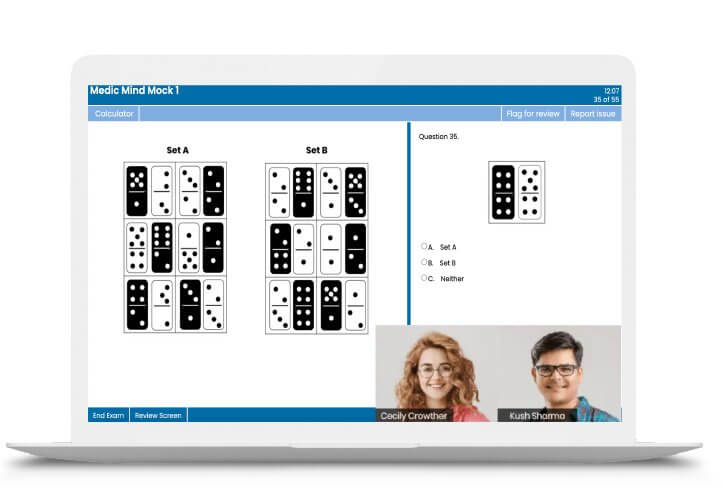Verbal Reasoning
17
Lessons
Q44
 21
21
Verbal Reasoning is officially the hardest UCAT section as I'm sure you would have found from our UCAT Practice Tests - in 2019, the average UK score was 565. In our in-depth lessons, we will teach you the optimal approach for each UCAT question type, whether its a long scientific passage or a tricky statement UCAT question.
Tutorials
- Lesson 1 Introduction to VR
- Lesson 2 True, False, Can’t Tell
- Lesson 3 Using Inferences
- Lesson 4 Extreme Language
- Lesson 5 Keyword Approach
- Lesson 6 Passage Adjustments
- Lesson 7 Writer Questions
- Lesson 8 Type 1 Statements
- Lesson 9 Type 2 Statements
- Lesson 10 Factual Passages
- Lesson 11 Timing Strategies
- Lesson 12 Reverse Questions
- Lesson 13 Timing Contingencies
- Lesson 14 Causation vs. Correlation
- Lesson 15 VR Test Day
- Lesson 16 Tips from the Experts
- Lesson 17 Summary and Overview
Lesson 1
Introduction to VR
To begin with, we give you a short overview of Verbal Reasoning, discussing the different types of UCAT questions, the UCAT timing and the key challenges you’ll face
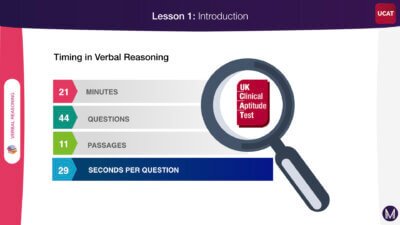 Accedi qui
Accedi qui
Lesson 2
True, False, Can’t Tell
Here we tackle the easier True, False, Can’t Tell UCAT questions. We’ll discuss what each of these terms actually mean, and using the UCAT Practice Tests, we'll consolidate your knowledge
 Accedi qui
Accedi qui
Lesson 3
Using Inferences
Inferences can change a statement from Can’t Tell to True. Being able to understand when you can and cannot make an inference is essential to scoring well in your UCAT Test.
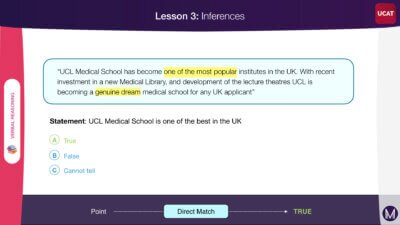 Accedi qui
Accedi qui
Lesson 4
Extreme Language
Here we will introduce one of our most effective Verbal Reasoning techniques - Extreme Language. We’ll discuss mild and extreme phrases, and how to spot them in the UCAT Test
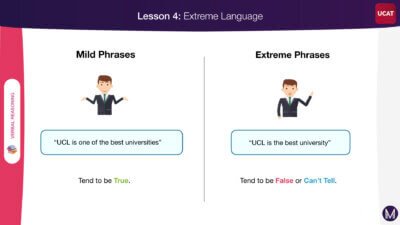 Accedi qui
Accedi qui
Lesson 5
Keyword Approach
To answer a Verbal Reasoning UCAT question in 30 seconds, you need to use the Keyword Approach. Here we introduce this vital technique and then practice using it in UCAT Practice Tests.
 Accedi qui
Accedi qui
Lesson 6
Passage Adjustments
Often there can be slight adjustments between the passage and the statement. We’ll teach you how to spot these, and avoid falling into these common Verbal Reasoning traps!
 Accedi qui
Accedi qui
Lesson 7
Writer Questions
Here we discuss how to approach longer, subjective Writer Passages, including how to quickly find the writer’s conclusion in a long UCAT passage which are common in the UCAT Test.
 Accedi qui
Accedi qui
Lesson 8
Type 1 Statements
In this tutorial, we tackle the more difficult Statement UCAT questions, discussing a range of techniques for time-saving and efficient working. We'll put together your knowledge of the UCAT 2019.
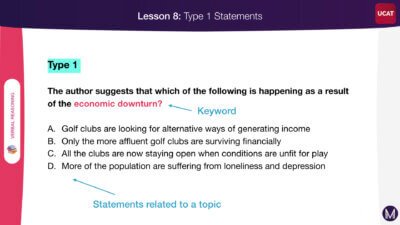 Accedi qui
Accedi qui
Lesson 9
Type 2 Statements
Here, we teach you how to apply our Verbal Reasoning techniques on the most difficult and long-winded UCAT questions in the UCAT Test - Type 2 Statement Questions.
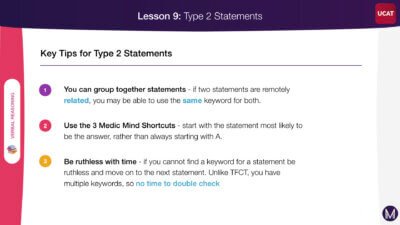 Accedi qui
Accedi qui
Lesson 10
Factual Passages
In this UCAT tutorial, we teach you how to successfully tackle the more complicated, abstract passages containing multiple numbers, facts and fine details - These are common in UCAT Practice Tests.
 Accedi qui
Accedi qui
Lesson 11
Timing Strategies
In this tutorial, we consolidate all of the timing techniques we’ve learnt thus far, alongside introducing some new tips for beating that UCAT Timer in Verbal Reasoning!
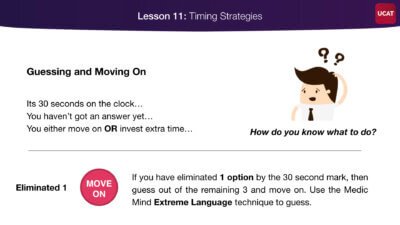 Accedi qui
Accedi qui
Lesson 12
Reverse Questions
Reverse or Negative UCAT Questions often trick UCAT students up. We’ll teach you how to spot them and answer them well in a limited amount of time. We'll put into practice all the UCAT you've covered so far!
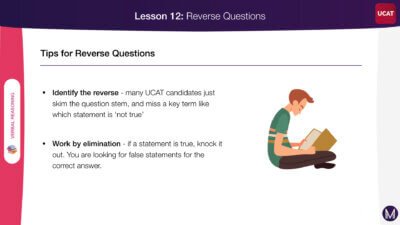 Accedi qui
Accedi qui
Lesson 13
Timing Contingencies
What do you do if you have 10 UCAT questions left to do in 5 minutes? Don’t worry, we’ll guide you through our contingency Cheetah and Rabbit strategies just in case things go wrong! We'll then do a UCAT Mini Mock
 Accedi qui
Accedi qui
Lesson 14
Causation vs. Correlation
It's easy to make assumptions on links and correlations between UCAT statements. In this tutorial, we’ll go through some tricky examples to teach you an important skill. This is handy to know for your UCAT Test.
 Accedi qui
Accedi qui
Lesson 15
VR Test Day
In this tutorial we’ll give you a week by week plan for your Verbal Reasoning preparation. We’ll also discuss how to perform at your best on UCAT Test Day.
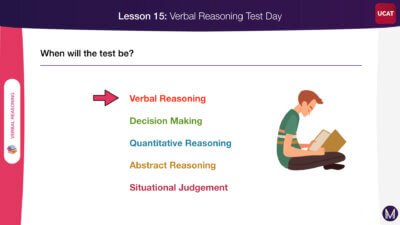 Accedi qui
Accedi qui
Lesson 16
Tips from the Experts
We close up the Verbal Reasoning course with some final tips from our UCAT experts, all of whom scored above 850 in the exam.
 Accedi qui
Accedi qui
Lesson 17
Summary and Overview
This revision lesson will re-cap all of the key UCAT Verbal Reasoning techniques we’ve taught you.
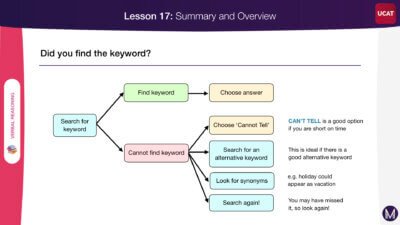 Accedi qui
Accedi qui
Decision Making
18
Lessons
Q29
 31 minutes
31 minutes
Decision Making is a relatively new section but also the hardest to grasp in terms of techniques. Watch our award-winning techniques to help you maximise your score in a challenging but fun section!
Tutorials
- Lesson 1 Introduction
- Lesson 2 Syllogisms: Theory
- Lesson 3 Syllogisms: Questions
- Lesson 4 Venn Diagrams I
- Lesson 5 Venn Diagrams II
- Lesson 6 Probability: Theory
- Lesson 7 Probability: Questions
- Lesson 8 Logic Puzzles: Theory
- Lesson 9 Logic Puzzles: Questions
- Lesson 10 Ordered Puzzles
- Lesson 11 Tabular Puzzles
- Lesson 12 Spatial Equations
- Lesson 13 Conditional Scenarios
- Lesson 14 Interpreting Data
- Lesson 15 Assumptions: Theory
- Lesson 16 Assumptions: Questions
- Lesson 17 Tips from Experts
- Lesson 18 Summary
Lesson 1
Introduction
To begin with, we give you a short overview of Decision Making, introduce the 6 UCAT question types and identify the key challenges faced.
 Accedi qui
Accedi qui
Lesson 2
Syllogisms: Theory
Here we teach you our evidence-based method for tackling Syllogisms using Venn Diagrams. Quite a detailed tutorial so brace yourself!
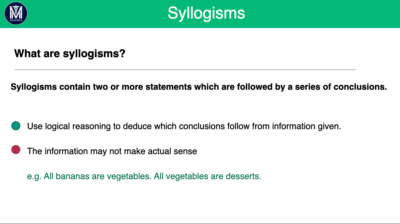 Accedi qui
Accedi qui
Lesson 3
Syllogisms: Questions
We now put this into practice by going through UCAT questions based on the official UCAT Consortium.
 Accedi qui
Accedi qui
Lesson 4
Venn Diagrams I
There are lots of UCAT questions which require you to draw a Venn without even telling you! It's a key part of Decision Making and you need to get familiar with it early.
 Accedi qui
Accedi qui
Lesson 5
Venn Diagrams II
We put these techniques into practice and tackle an array of UCAT questions designed to test you to your limit.
 Accedi qui
Accedi qui
Lesson 6
Probability: Theory
Whether you have a basic or expert level of knowledge of maths, Decision Making Probability will give you a refresher and help you cover the content in detail.
 Accedi qui
Accedi qui
Lesson 7
Probability: Questions
After covering the content you will put it into practice and go through UCAT Probability Questions
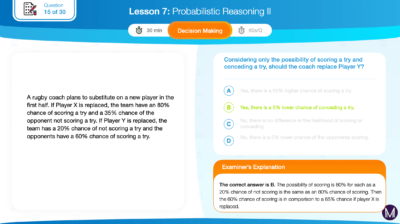 Accedi qui
Accedi qui
Lesson 8
Logic Puzzles: Theory
This is a favourite for UCAT Decision Making authors and a UCAT question style bound to trip up many so pay attention to this one!
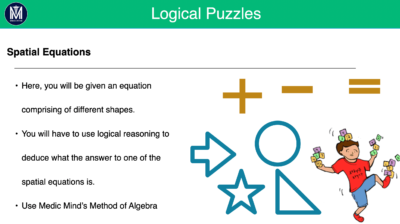 Accedi qui
Accedi qui
Lesson 9
Logic Puzzles: Questions
Logical Puzzles in Decision Making require lots and lots of practice so watch our walkthrough video to help guide you through it all.
 Accedi qui
Accedi qui
Lesson 10
Ordered Puzzles
In this UCAT Tutorial we go through how to answer ordered puzzle UCAT questions as well as covering vital theory to help you score 800+
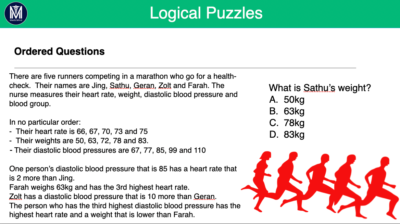 Accedi qui
Accedi qui
Lesson 11
Tabular Puzzles
UCAT Decision Making tends to have lots of information in tables and they purposely distract you with overload of information. Learn how to tackle these UCAT questions.
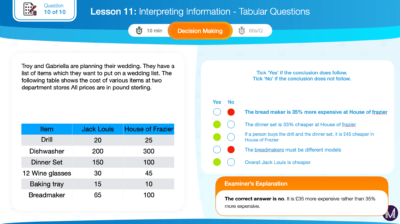 Accedi qui
Accedi qui
Lesson 12
Spatial Equations
These have come up in the past two years of the UCAT Decision Making based on our research so it's an important UCAT question type to get your head around.
 Accedi qui
Accedi qui
Lesson 13
Conditional Scenarios
Here we get to grips with how UCAT Decision Making requires you to have two-step thinking and help you take shortcuts.
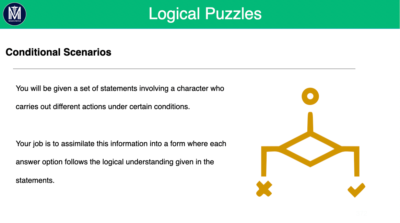 Accedi qui
Accedi qui
Lesson 14
Interpreting Data
It's crucial to know how to consolidate pieces of information in UCAT Decision Making and score highly by not being fooled by distractors
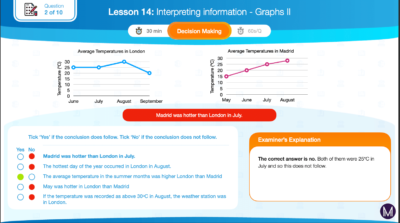 Accedi qui
Accedi qui
Lesson 15
Assumptions: Theory
Recognising Assumption UCAT Questions are relatively straightforward but we discuss the common pitfalls that students face.
 Accedi qui
Accedi qui
Lesson 16
Assumptions: Questions
These are the easiest type of UCAT Decision Making questions however it helps to get 100% in these UCAT questions to set you up for the rest of it.
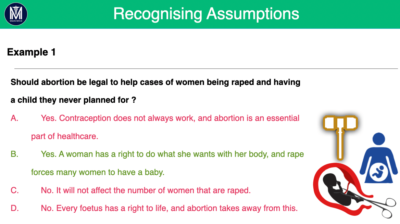 Accedi qui
Accedi qui
Lesson 17
Tips from Experts
Hear from UCAT Decision Making experts who can give you their insight into how they did well in this area and what they found useful.
 Accedi qui
Accedi qui
Lesson 18
Summary
Here we wrap up everything we've taught you and help condense everything into the salient points as well as telling you the next steps on how to formulate your revision.
 Accedi qui
Accedi qui
Quantitative Reasoning
18
Lessons
Q36
 24 min
24 min
We approach Quantitative Reasoning by systematically working through the 15 key question types that appear in the UCAT. Whether it be Percentages, Ratios, Fractions, Venn Diagrams, Tax Questions or Areas, we've got you covered!
Tutorials
- Lesson 1 Introduction to QR
- Lesson 2 Estimation vs. Precision
- Lesson 3 Reading The Information
- Lesson 4 Units in the UCAT
- Lesson 5 Means, Median, Mode
- Lesson 6 Area Questions
- Lesson 7 Quantitative Formulae
- Lesson 8 Ratios
- Lesson 9 The UCAT Calculator
- Lesson 10 Fractions
- Lesson 11 Interest Questions
- Lesson 12 Tax Questions
- Lesson 13 Venn Diagrams
- Lesson 14 Percentages
- Lesson 15 Speed, Distance, Time
- Lesson 16 Tips from Experts
- Lesson 17 QR Test Day
- Lesson 18 Summary and Overview
Lesson 1
Introduction to QR
We begin with an overview of Quantitative Reasoning. What is the timing? What types of UCAT questions commonly come up? What are the key challenges? We use the official UCAT Practice Tests to help guide us.
 Accedi qui
Accedi qui
Lesson 2
Estimation vs. Precision
A key technique for saving time is estimation. We teach you when to estimate, how to estimate, and work through different UCAT scenarios to challenge your technique. Using the official UCAT Practice Tests will ensure we're on the right track.
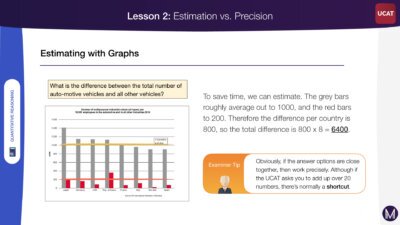 Accedi qui
Accedi qui
Lesson 3
Reading The Information
It's crucial to understand when to read the QR UCAT question stem, and when to skim read. We teach you how to recognise the type of UCAT question, and the approach to take.
 Accedi qui
Accedi qui
Lesson 4
Units in the UCAT
In this UCAT tutorial, we work through unit variation in UCAT questions, common units traps, unit conversions and time-saving tips for units UCAT questions.
 Accedi qui
Accedi qui
Lesson 5
Means, Median, Mode
Here we work through realistic UCAT scenarios relating to means, weighted means, median and longer time-consuming data calculations. We'll also do some UCAT Practice to consolidate this!
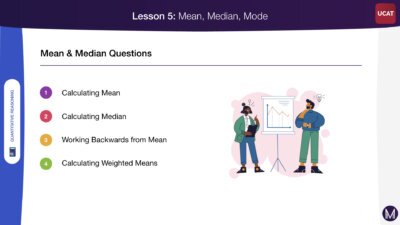 Accedi qui
Accedi qui
Lesson 6
Area Questions
UCAT area questions can often be challenging, time-consuming and tricky. We’ll tackle the most common area UCAT questions, teaching you some successful strategies. You can also bring in any UCAT Practice Tests you've done to help.
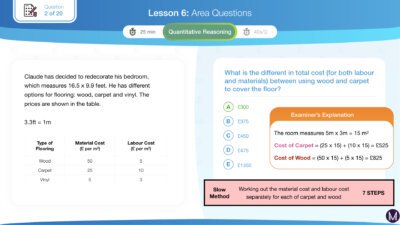 Accedi qui
Accedi qui
Lesson 7
Quantitative Formulae
We practice using common UCAT formulae - such as the area of a cylinder, volume of a sphere, diameter of a polygon, use of pi and much more. We'll finish with a UCAT Practice Test to ensure you've taken it all on board.
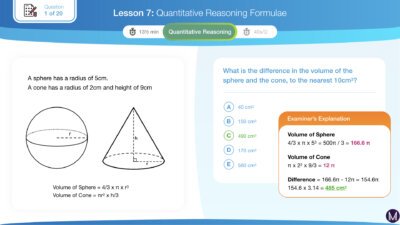 Accedi qui
Accedi qui
Lesson 8
Ratios
You often need to use ratios within UCAT questions, whether it be in a map scale, or calculating proportions of items. Ratios can be tricky, but don’t worry we have you covered and we'll do lots of UCAT Practice Tests to make sure!
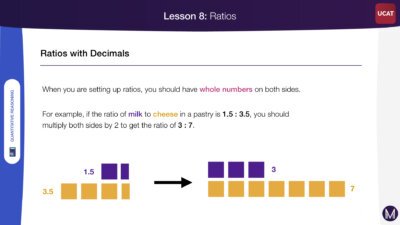 Accedi qui
Accedi qui
Lesson 9
The UCAT Calculator
The UCAT Calculator really slows you down. We’ll teach you how to use it quickly and efficiently using our proven shortcuts. We’ll also discuss the UCAT Whiteboard and Flagging function.
 Accedi qui
Accedi qui
Lesson 10
Fractions
Being able to use and convert fractions is a very useful skill for UCAT Quantitative Reasoning. Using our UCAT Practice Techniques, by the end of this tutorial fractions we will make ‘fractions your friend’!
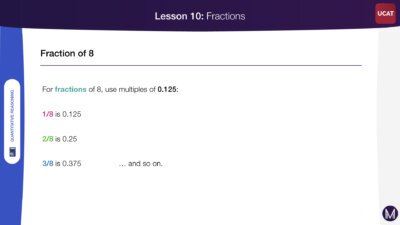 Accedi qui
Accedi qui
Lesson 11
Interest Questions
Compound interest, simple interest, interest calculations - these are common nightmares for UCAT students. In this tutorial, we challenge you with some time-consuming UCAT Practice Tests
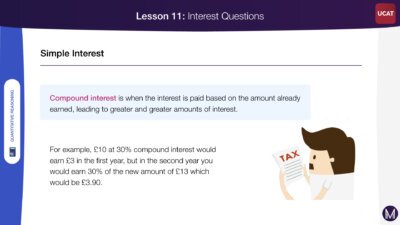 Accedi qui
Accedi qui
Lesson 12
Tax Questions
Tax bracket calculations have commonly been asked in the UCAT, and students struggle to get their head around them. In this tutorial, we will work through many examples to overcome your fear in UCAT Practice Tests!
 Accedi qui
Accedi qui
Lesson 13
Venn Diagrams
Being able to use, draw and understand Venn Diagrams is an essential skill in both the Quantitative Reasoning and Decision Making sections of the UCAT Test 2020 and we'll do lots of UCAT Practice Tests!
 Accedi qui
Accedi qui
Lesson 14
Percentages
Percentages are almost guaranteed to come up in the UCAT as you would have seen in UCAT Practice Tests! We teach you a unique, super fast method for percentage change, increase and proportions. You never know what's going to come up in the UCAT Test!
 Accedi qui
Accedi qui
Lesson 15
Speed, Distance, Time
In this tutorial we work through examples relating to the Speed, Distance, Time Formula. We will teach you how to avoid common traps for these UCAT questions (e.g. unit traps). UCAT Practice makes perfect we say!
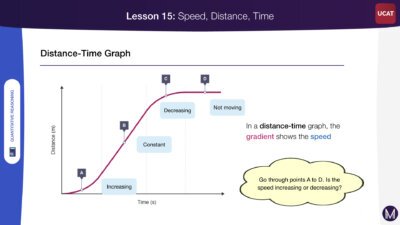 Accedi qui
Accedi qui
Lesson 16
Tips from Experts
We close up the Quantitative Reasoning course with some final tips from our UCAT experts, all of whom scored above 850 in the exam. They have written many of the official UCAT Practice Tests!
 Accedi qui
Accedi qui
Lesson 17
QR Test Day
In this tutorial we’ll give you a week by week plan for your Quantitative Reasoning preparation. We’ll also discuss how to perform at your best on UCAT Test Day.
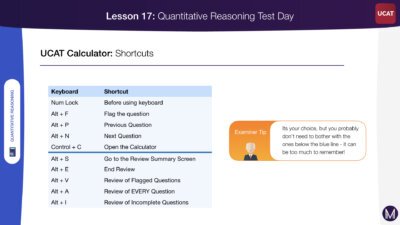 Accedi qui
Accedi qui
Lesson 18
Summary and Overview
This revision lesson will re-cap all of the key UCAT Quantitative Reasoning techniques we’ve taught you. You can also send us some UCAT Practice Tests you may have found hard.
 Accedi qui
Accedi qui
Abstract Reasoning
20
Lessons
Q55
 13 minutes
13 minutes
Abstract Reasoning is a tricky section to grasp especially as there are so many different patterns you could get! We'll teach you award-winning methods to help you crack through the UCAT questions using pattern recognition techniques.
Tutorials
- Lesson 1 Introduction
- Lesson 2 AR Question Types
- Lesson 3 Warm Up Quiz
- Lesson 4 Type 1 Questions
- Lesson 5 The SPONCS Method
- Lesson 6 AR Triggers
- Lesson 7 Number Patterns
- Lesson 8 Shape Patterns
- Lesson 9 Size Patterns
- Lesson 10 Position Patterns
- Lesson 11 Colour Patterns
- Lesson 12 Orientation Patterns
- Lesson 13 Distractors
- Lesson 14 Dependent Patterns
- Lesson 15 Secondary Patterns
- Lesson 16 Timing Strategies
- Lesson 17 Type 2 Questions
- Lesson 18 Type 3 Questions
- Lesson 19 Type 4 Questions
- Lesson 20 AR Test Day
Lesson 1
Introduction
We begin with an overview of Abstract Reasoning, including a summary of UCAT question types, the common pitfalls and the key techniques required. We'll quiz you by doing some AR UCAT Practice Tests
 Accedi qui
Accedi qui
Lesson 2
AR Question Types
There are 4 Abstract Reasoning UCAT question types. In this tutorial, we introduce each one, and discuss the differences in approach, timing and difficulty.
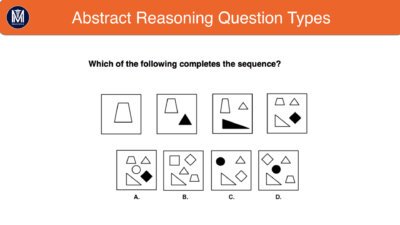 Accedi qui
Accedi qui
Lesson 3
Warm Up Quiz
In this tutorial we warm you up with some practice patterns before we jump into trickier sets later on. You’ll be able to see how AR works, and understand how to spot patterns. It's essentially a mini UCAT Practice Test!
 Accedi qui
Accedi qui
Lesson 4
Type 1 Questions
Type 1 UCAT Questions are the most common type in Abstract Reasoning. We will discuss the ideal strategy for these UCAT questions, and practice some sets. Grasped the UCAT theory? We'll see in our UCAT Practice Test!
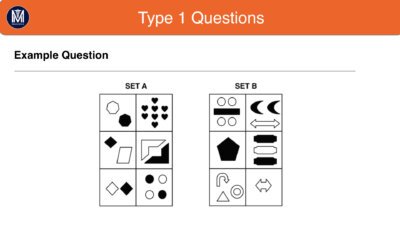 Accedi qui
Accedi qui
Lesson 5
The SPONCS Method
In this tutorial we will summarise the key types of patterns that appear in the UCAT Test, including Shape, Position, Orientation, Number, Colour and Size patterns.
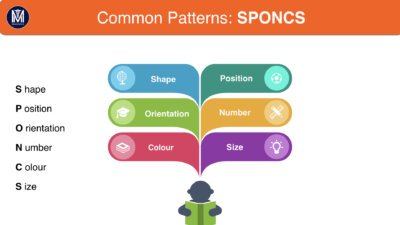 Accedi qui
Accedi qui
Lesson 6
AR Triggers
In AR, you haven’t got enough type to look for every pattern from SPONCS. You need to spot triggers, which will guide you towards the right direction and save crucial time.
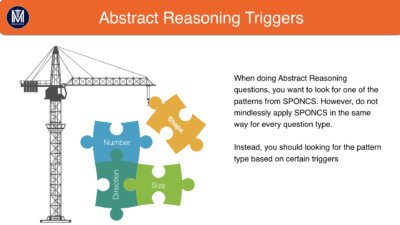 Accedi qui
Accedi qui
Lesson 7
Number Patterns
UCAT Practice Tests have quite a few number patterns, including the number of sides, number of total shapes, number of intersections and much more.
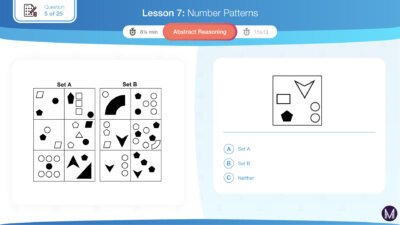 Accedi qui
Accedi qui
Lesson 8
Shape Patterns
UCAT Practice Tests tend to have a lot of shape patterns, including presence of a specific shape, symmetry, curved vs. straight-sides, regular vs. irregular and much more.
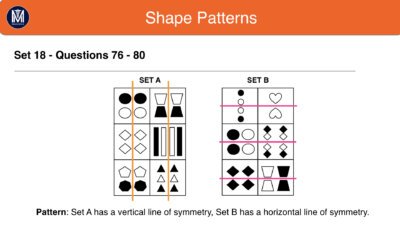 Accedi qui
Accedi qui
Lesson 9
Size Patterns
We will teach you how to look for common patterns relating to the relative size of shapes, including common combinations of Size with other pattern types. This will be in keeping with the official UCAT Practice Tests
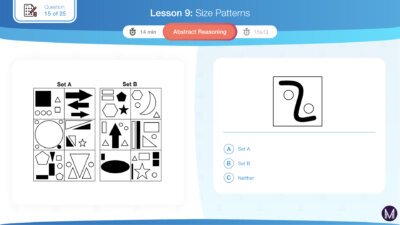 Accedi qui
Accedi qui
Lesson 10
Position Patterns
We will teach you how to look for common Position patterns, and how they appear on common UCAT Practice Tests
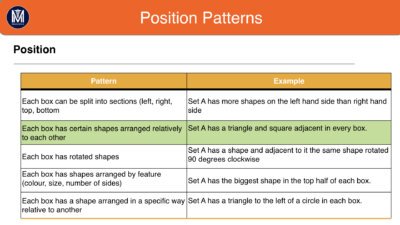 Accedi qui
Accedi qui
Lesson 11
Colour Patterns
We will teach you how to look for common Colour patterns, including patterns involving grey, black, striped and spotted shapes. UCAT Practice Tests often don't focus on colour patterns but we like being thorough!
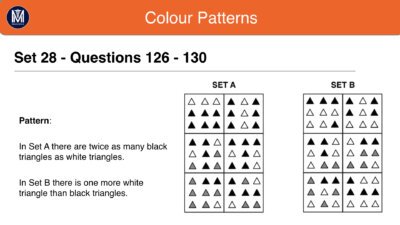 Accedi qui
Accedi qui
Lesson 12
Orientation Patterns
We will teach you how to look for Orientation patterns, including patterns involving direction, arrows and relative position of shapes. UCAT Practice Tests have a lot of this.
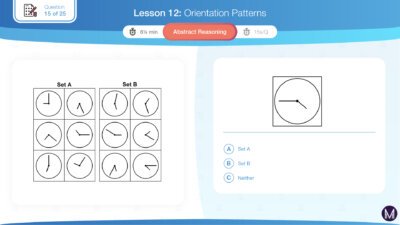 Accedi qui
Accedi qui
Lesson 13
Distractors
UCAT questions often have distractor shapes and boxes, which are designed to waste your time. We’ll explain how to spot them, avoid them and focus on the important shapes. We can also go through the official UCAT Practice Tests
 Accedi qui
Accedi qui
Lesson 14
Dependent Patterns
Sometimes patterns involve two steps, whereby one pattern depends on another pattern. These UCAT questions can be tricky, so we will practice them and discuss the best approach. UCAT Practice Test B contains 3-4 UCAT Questions on Dependent Patterns
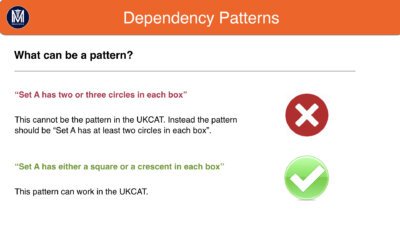 Accedi qui
Accedi qui
Lesson 15
Secondary Patterns
Sometimes sets have two patterns - one major pattern, and one minor pattern. We will discuss when to look for a second pattern, and when to save time and move on. To see how much you've learned, we'll also do a UCAT Practice Test!
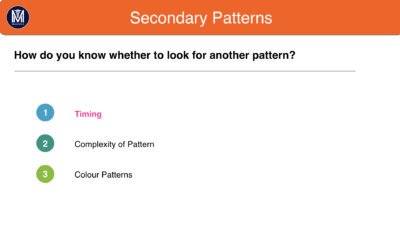 Accedi qui
Accedi qui
Lesson 16
Timing Strategies
Abstract Reasoning is the quickest UCAT section. It can fly by, so it's especially important to be sharp with your timing. We will teach you how to spot patterns efficiently and quickly. UCAT Practice makes perfect we say!
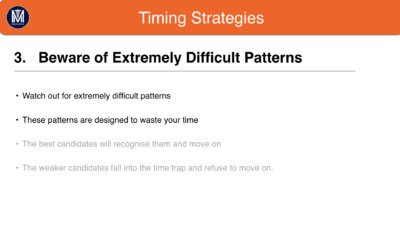 Accedi qui
Accedi qui
Lesson 17
Type 2 Questions
Type 2 Abstract Reasoning UCAT Questions involve a series of shapes, with the UCAT question asking you to finish the series. We will work through examples, and teach you how to approach them. UCAT Practice B Test has a lot of these!
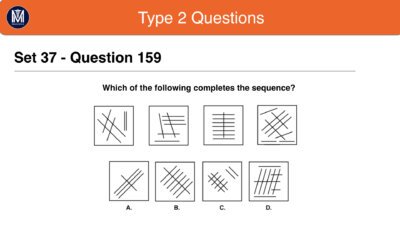 Accedi qui
Accedi qui
Lesson 18
Type 3 Questions
Type 3 Abstract Reasoning UCAT questions involves spotting relationships between pairs of shapes. We will work through several examples, and again discuss the best approach. Practicing the UCAT will help you ace this section!
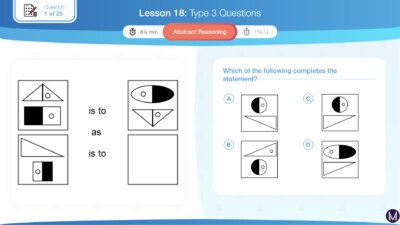 Accedi qui
Accedi qui
Lesson 19
Type 4 Questions
Type 4 Abstract Reasoning UCAT questions involve a similar approach to Type 1 UCAT questions, with a slight twist. We will practice, discuss and perfect your technique for these UCAT questions. To see how much you've learned, we'll also do a UCAT Practice Test!
 Accedi qui
Accedi qui
Lesson 20
AR Test Day
In this tutorial we’ll give you a week by week plan for your Abstract Reasoning preparation. We’ll also discuss how to perform at your best on UCAT Test Day.
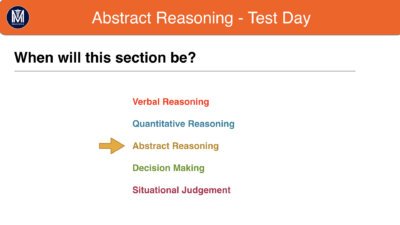 Accedi qui
Accedi qui
Situational Judgement
18
Lessons
Q69
 25 Minutes
25 Minutes
We approach Situational Judgement by working through the GMC Guidelines and Medical Ethics to help you understand the ethical knowledge and grasp the UCAT techniques required to secure Band 1.
Tutorials
- Lesson 1 Introduction to SJT
- Lesson 2 Appropriateness
- Lesson 3 Importance
- Lesson 4 Tackling the Scenario
- Lesson 5 Knowing Your Role
- Lesson 6 Key Principles
- Lesson 7 Patient Safety
- Lesson 8 Working with Remits
- Lesson 9 Confidentiality
- Lesson 10 Professionalism
- Lesson 11 Honesty & Integrity
- Lesson 12 Teamwork & Respect
- Lesson 13 Duties of a Doctor
- Lesson 14 GMC #1: Performance
- Lesson 15 GMC #2: Safety
- Lesson 16 GMC #3: Teamwork
- Lesson 17 GMC #4: Trust
- Lesson 18 Medical Pillars
Lesson 1
Introduction to SJT
Here we breakdown the different UCAT question types you can get in the Situational Judgement section of the exam and help you adjust to the UCAT skills required here.
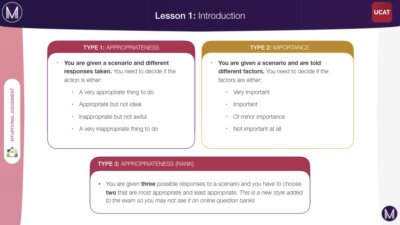 Accedi qui
Accedi qui
Lesson 2
Appropriateness
In this lesson, we start looking at the "appropriateness" type of UCAT questions and lay out a step by step strategy on how to answer UCAT questions related to this. To see how much you've learned, we'll also do a UCAT Practice Test!
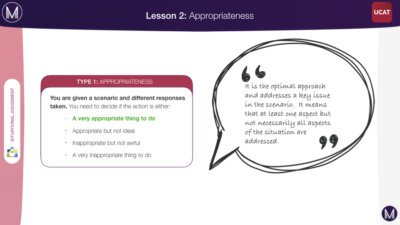 Accedi qui
Accedi qui
Lesson 3
Importance
We look at the "importance" type of UCAT questions in Situational Judgement and help you understand how to differentiate between very important and not important at all. UCAT Practice Tests really pride themselves on this.
 Accedi qui
Accedi qui
Lesson 4
Tackling the Scenario
Here we give you our expert strategies from our UCAT Practice Tests which has been devised by current doctors and medical students based on their insight into the clinical environment.
 Accedi qui
Accedi qui
Lesson 5
Knowing Your Role
When you are faced with a scenario, you have to identify the status and profession of the person involved. UCAT Practice Test A mentions this a lot on the official UCAT website.
 Accedi qui
Accedi qui
Lesson 6
Key Principles
We give you an overview of the principles of situational judgement including patient safety and professionalism. Lots of UCAT Questions and UCAT Practice Tests on this!
 Accedi qui
Accedi qui
Lesson 7
Patient Safety
The most important thing you are taught as a medical student is to always be safe! It is drilled in and is the most important quality in medicine. We'll check this by doing some UCAT Practice Tests.
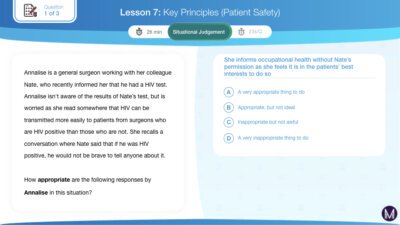 Accedi qui
Accedi qui
Lesson 8
Working with Remits
This applies in particular to situations revolving around medical students - Medical students are not authorised to make decisions surrounding medical care or give any treatment. We'll show you some UCAT Practice Tests too.
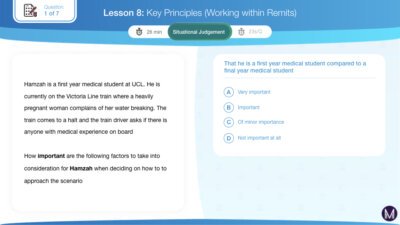 Accedi qui
Accedi qui
Lesson 9
Confidentiality
Confidentiality is important for many reasons - this includes patient trust in the profession. Patients are often anxious to come to doctors and so when they do inform them of information they expect that it will not be told to anyone else. We'll go through some UCAT questions and do some UCAT Practice Tests
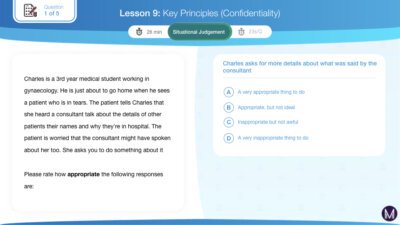 Accedi qui
Accedi qui
Lesson 10
Professionalism
Doctors and dentists should be responsible in healthcare setting and outside healthcare settings. This means that all students and doctors should act responsibly as they are representing a whole profession. We can put it all together here through UCAT practice tests.
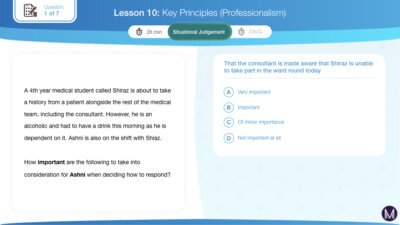 Accedi qui
Accedi qui
Lesson 11
Honesty & Integrity
Everyone makes mistakes and it's important that if mistakes are made that we follow the right protocol to identify them. You should not directly influence patients’ decision - We have 5 UCAT Practice Tests here that we can cover.
 Accedi qui
Accedi qui
Lesson 12
Teamwork & Respect
No one is above anyone else - it’s why doctors and nurses wear the same type of scrubs. We go through common SJT scenarios around this and help you spot key patterns in their UCAT questions. We can do a few UCAT Practice Tests here as well.
 Accedi qui
Accedi qui
Lesson 13
Duties of a Doctor
Here we condense the GMC Principles in a series of short videos with interactive UCAT question-based tutorials. UCAT Practice is essentially and we'll go over why in this tutorial.
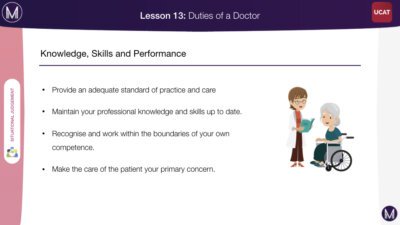 Accedi qui
Accedi qui
Lesson 14
GMC #1: Performance
We go through the first GMC principle of Knowledge, Skills & Performance and go through Situational Judgement UCAT questions around it.
 Accedi qui
Accedi qui
Lesson 15
GMC #2: Safety
We go through the second GMC principle of Safety and Quality and go through Situational Judgement UCAT questions around it. The GMC have strict guidelines which we'll go through via UCAT Questions
 Accedi qui
Accedi qui
Lesson 16
GMC #3: Teamwork
We go through the third GMC principle of Communication, Partnership & Teamwork and go through Situational Judgement UCAT questions around it. This will follow a UCAT Practice Test to consolidate this theory.
 Accedi qui
Accedi qui
Lesson 17
GMC #4: Trust
We go through the fourth GMC principle and go through Situational Judgement UCAT questions around it. We'll also do a UCAT Practice Test to consolidate this theory.
 Accedi qui
Accedi qui
Lesson 18
Medical Pillars
We discuss the 4 Key Medical Pillars and talk through real life SJT scenarios to help you get to grips with the exam. We'll also do a UCAT Practice Test to master this theory.
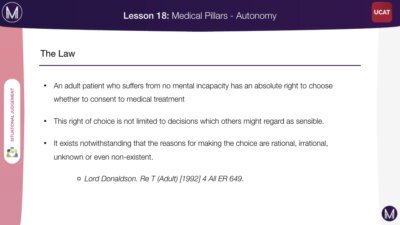 Accedi qui
Accedi qui
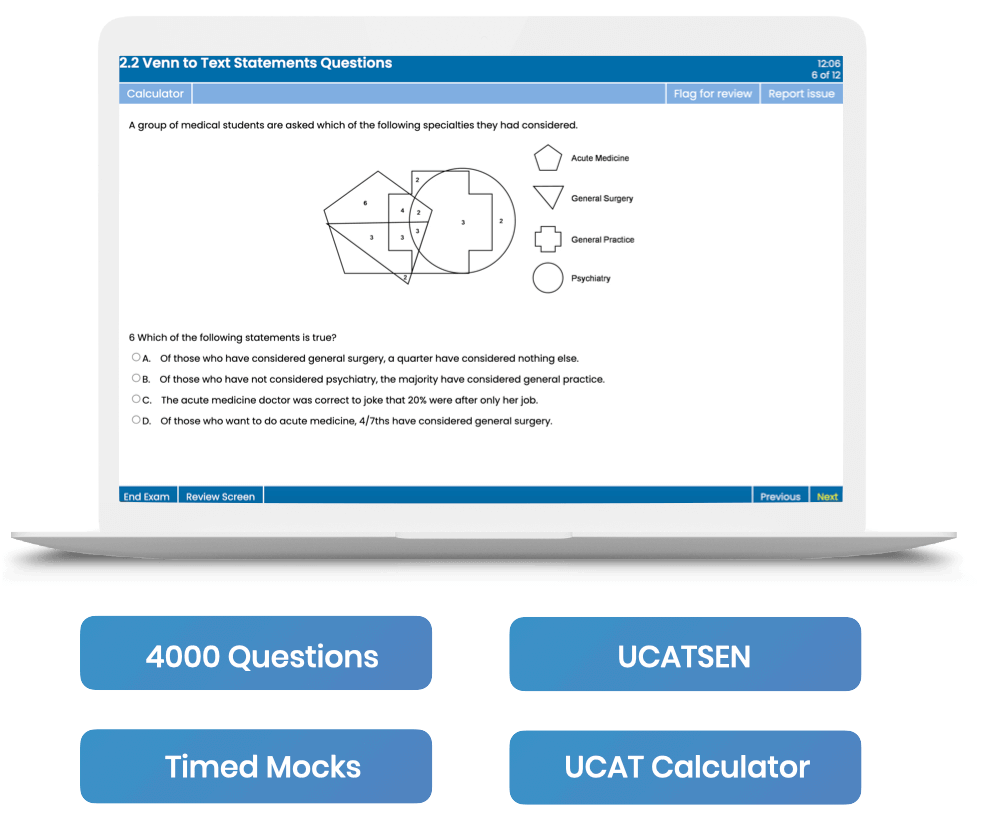


 Accedi qui
Accedi qui
 Accedi qui
Accedi qui
 Accedi qui
Accedi qui
 Accedi qui
Accedi qui
 Accedi qui
Accedi qui
 Accedi qui
Accedi qui
 Accedi qui
Accedi qui
 Accedi qui
Accedi qui
 Accedi qui
Accedi qui
 Accedi qui
Accedi qui
 Accedi qui
Accedi qui
 Accedi qui
Accedi qui
 Accedi qui
Accedi qui
 Accedi qui
Accedi qui
 Accedi qui
Accedi qui
 Accedi qui
Accedi qui
 Accedi qui
Accedi qui



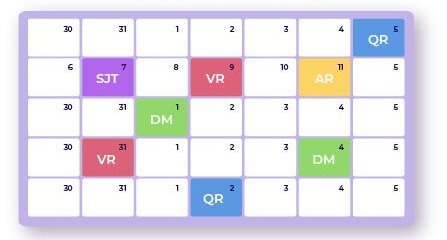

 Accedi qui
Accedi qui
